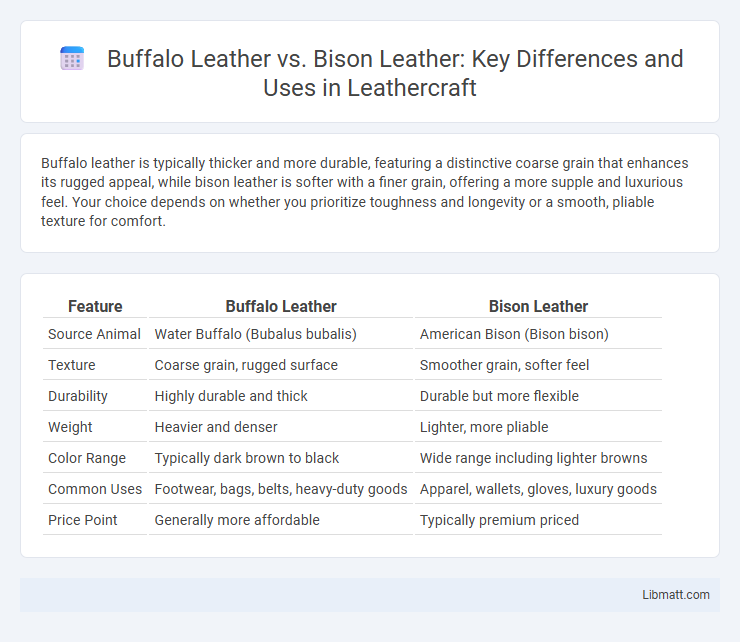Buffalo leather is typically thicker and more durable, featuring a distinctive coarse grain that enhances its rugged appeal, while bison leather is softer with a finer grain, offering a more supple and luxurious feel. Your choice depends on whether you prioritize toughness and longevity or a smooth, pliable texture for comfort.
Table of Comparison
| Feature | Buffalo Leather | Bison Leather |
|---|---|---|
| Source Animal | Water Buffalo (Bubalus bubalis) | American Bison (Bison bison) |
| Texture | Coarse grain, rugged surface | Smoother grain, softer feel |
| Durability | Highly durable and thick | Durable but more flexible |
| Weight | Heavier and denser | Lighter, more pliable |
| Color Range | Typically dark brown to black | Wide range including lighter browns |
| Common Uses | Footwear, bags, belts, heavy-duty goods | Apparel, wallets, gloves, luxury goods |
| Price Point | Generally more affordable | Typically premium priced |
Introduction to Buffalo and Bison Leather
Buffalo leather is derived from the water buffalo, primarily found in Asia, known for its durability and coarser grain texture, while bison leather comes from the North American bison, prized for its softness and distinctive natural markings. Both types exhibit high strength, making them ideal for rugged leather goods, but bison leather generally offers a more supple feel and unique grain patterns. The choice between buffalo and bison leather depends on desired texture, appearance, and application, with buffalo leather favored for toughness and bison leather for luxurious leather products.
Origins: Buffalo vs Bison
Buffalo leather primarily originates from water buffalo found in Asia, especially in countries like India and the Philippines, whereas bison leather comes from the American bison native to North America. Despite both terms often being used interchangeably, buffalo leather tends to be thicker and more durable due to the water buffalo's rugged environment, while bison leather is softer with a unique grain pattern. Understanding these origins helps you choose the right type of leather based on texture, durability, and ethical sourcing preferences.
Visual Appearance and Grain Differences
Buffalo leather features a more uniform and tighter grain pattern with a smoother surface, while bison leather displays a rougher, coarser texture with larger, more pronounced grain and natural scars. The visible markings on bison leather give it a rugged and distinctive look, making each piece unique, whereas buffalo leather tends to have a polished and consistent visual appeal. Your choice between buffalo and bison leather will depend on whether you prefer a refined appearance or a more rustic, textured aesthetic.
Durability and Strength Comparison
Buffalo leather is known for its tight grain and firmness, offering excellent durability and resistance to wear, while bison leather features a looser grain with natural texture that provides superior strength and flexibility. Both types resist stretching and abrasion well, but bison leather tends to soften and become more supple over time without compromising its robust structure. Your choice between the two depends on whether you prioritize a sturdier, consistent feel (buffalo) or a resilient, naturally textured finish (bison).
Texture and Flexibility
Buffalo leather features a coarse, grainy texture with a firm and sturdy feel, offering moderate flexibility that softens with use. Bison leather, derived from a different species, exhibits a finer, more supple texture with pronounced natural grain patterns, providing enhanced flexibility and a softer hand. Both materials are durable, but bison leather tends to mold more comfortably to the wearer's shape over time due to its superior pliability.
Common Uses and Applications
Buffalo leather is widely used in the production of durable footwear, belts, and heavy-duty bags due to its toughness and resistance to wear. Bison leather, prized for its softer texture and unique grain patterns, is often chosen for high-end apparel, wallets, and upholstery. Your selection depends on whether you prioritize rugged durability or a luxury finish in your leather goods.
Aging and Patina Development
Buffalo leather develops a rich patina over time due to its dense grain and natural oils, enhancing its durability and aesthetic appeal with age. Bison leather, characterized by its looser grain and softer texture, also ages gracefully but forms a more pronounced, rugged patina that highlights unique markings and natural scars. Both leathers improve with use, but buffalo leather offers a smoother, more uniform aging pattern, while bison leather provides a distinctive, rustic character as it matures.
Maintenance and Care Requirements
Buffalo leather requires regular conditioning with a high-quality leather conditioner to maintain its suppleness and prevent cracking, especially in dry climates. Bison leather, known for its natural oils and dense fiber structure, demands less frequent conditioning but should still be cleaned with a damp cloth to avoid dirt buildup. Both types benefit from storing in a cool, dry place away from direct sunlight to preserve their texture and color longevity.
Environmental and Ethical Considerations
Buffalo leather, often sourced from domesticated water buffalo, generally features a more sustainable supply chain due to the animals' integration into agricultural systems, leading to less habitat disruption compared to wild bison. Bison leather, derived from wild or managed bison herds, carries ethical concerns related to wildlife management and habitat conservation, with certified sustainable harvesting practices playing a crucial role in minimizing environmental impact. Both types emphasize the importance of responsible sourcing and tanning processes to reduce chemicals and water usage for eco-friendly leather production.
Price and Market Value Analysis
Buffalo leather generally commands a higher market price compared to bison leather due to its greater availability and durability, making it a preferred choice in luxury leather goods. The market value of bison leather is often influenced by its rarity and distinct texture, which appeals to niche segments but results in less mass-market demand. Pricing for both varies widely based on factors such as tanning quality and grade, but buffalo leather remains more competitively priced for mainstream consumers.
Buffalo leather vs bison leather Infographic

 libmatt.com
libmatt.com